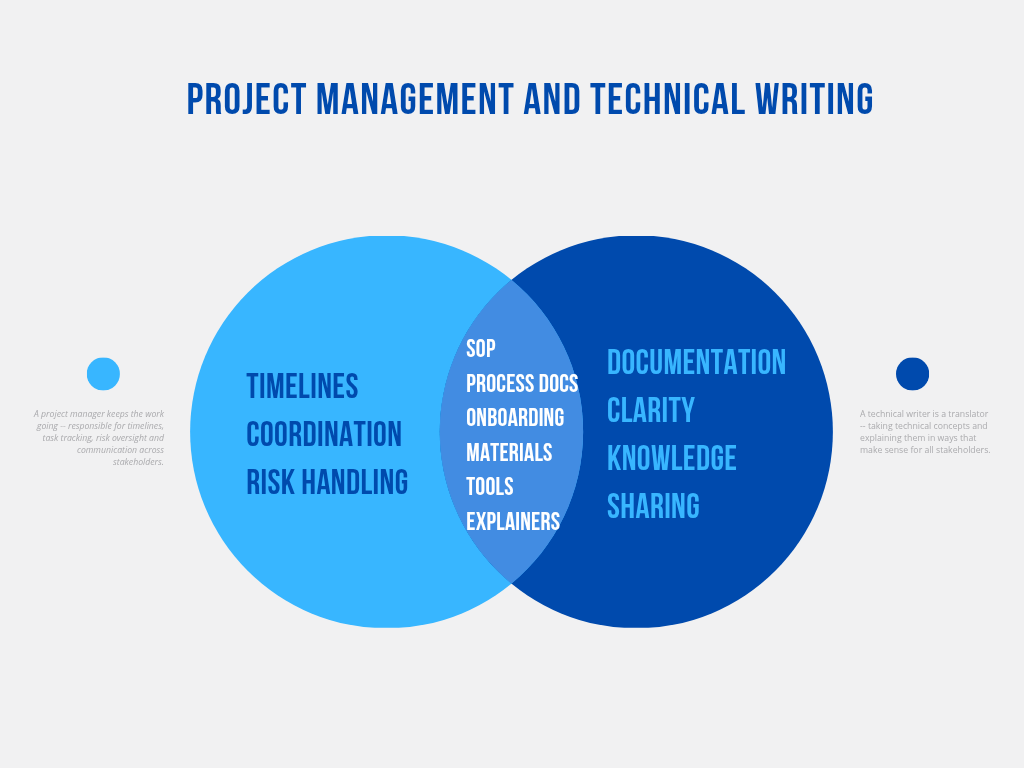Where Project Management Meets Technical Writing
Why This Overlap Matters
In most companies, project managers and technical writers live on different planets. One is racing the clock to keep deliverables on track. The other is deep in documentation, translating complexity into clarity. But what happens when someone can do both — and does?
Let’s talk about where project management and technical writing intersect, why it’s rare, and why it matters more than ever for growing teams.
What Each Role Typically Involves
Project Managers (PMs) keep the trains running. They’re responsible for timelines, task tracking, risk mitigation, and communication across stakeholders. Their superpower? Orchestrating chaos into progress.
Technical Writers, on the other hand, are translators. They take technical concepts — code, processes, infrastructure — and explain them in ways that make sense. Whether it’s internal documentation, user guides, or API references, they write the stuff that helps people do their jobs.
Both roles require clarity, structure, and strong communication. But they rarely sit in the same chair.
Where They Intersect (and Why That’s Rare)
There’s a sweet spot where PM and technical writing overlap: process.
Think about:
Writing step-by-step project procedures
Documenting tools or systems that support a team’s workflow
Translating technical updates into digestible reports or decks
Communicating complex rollout plans across technical and non-technical audiences
Someone who can both run the project and explain the system is rare — because these roles are usually siloed. But in reality, the skills are deeply complementary.
I’ve spent my career bridging this gap. I’ve written compliance procedures and managed the projects to implement them. I’ve built dashboards and automation flows — and then trained teams on how to use them. I’ve created Software Development Life Cycle (SDLC) governance guides while facilitating the programs they’re tied to.
The overlap saves time, reduces errors, and ensures consistency.
Real-World Moments Where Both Skill Sets Mattered
Compliance Project Turnaround: At one bank, I led a remediation initiative to meet the Office of the Comptroller of Currency (OCC) regulations. We needed an agile plan, but also documentation for every change. I created the action plans, ran the stand-ups, and wrote the guides that auditors would later review.
Product Maturity Across 17 Projects: I wasn’t just aligning roadmaps — I was documenting the frameworks and procedures that kept everything consistent. Teams didn’t just do the work; they understood why and how, because the info was clear.
Tool Adoption + Training: After introducing Power BI and Power Automate across a risk portfolio, I built user-friendly walkthroughs so teams weren’t left in the dark. Adoption rates jumped because people knew what to do with the tools.
In all of these, success came from not just moving work forward — but making the work legible.
Why Founders and Creators Should Care
If you’re a founder, a solo operator, or a fast-moving team, you don’t have time to play translator between your project manager and your tech writer — assuming you even have both.
Working with someone who can do both means:
Fewer dropped balls
Clearer comm
unication
Less time on-boarding people into your systems
And better documentation that actually reflects your process
It’s not just about getting things done. It’s about making sure they’re done well — and can be repeated, shared, or scaled.
Know someone drowning in chaos and documentation? Forward this their way.
And if that someone is you? Let’s talk.
